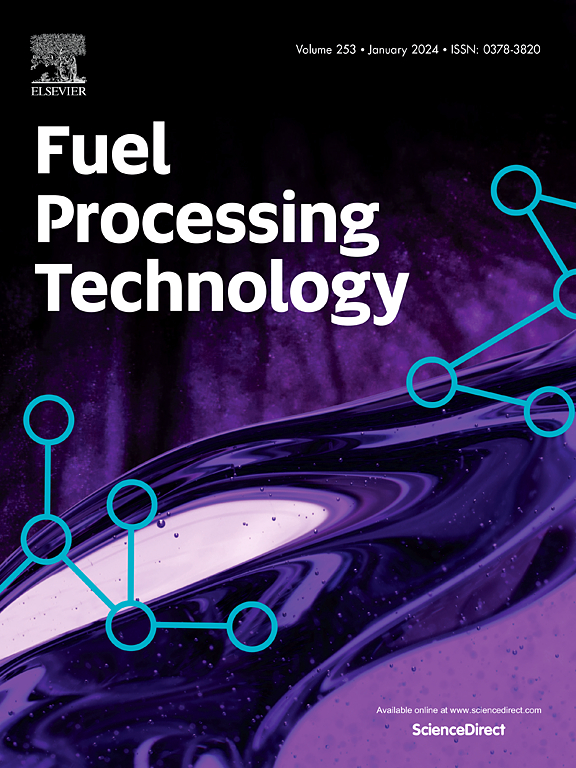Identifying and enhancing the spillover of crucial intermediates on the Fischer–Tropsch catalyst: A mechanistic approach
IF 7.2
2区 工程技术
Q1 CHEMISTRY, APPLIED
引用次数: 0
Abstract
Understanding and enhancing spillover phenomena in Fischer–Tropsch Synthesis (FTS) is critical for optimizing catalyst performance. In this study, we present a comprehensive evaluation of hydrogen, carbon monoxide, and water (θ-H, θ-CO, and θ-H2O) spillover mechanisms over a series of engineered multi-shell nanocomposite catalysts: Co@C(Z-d)@SiO2@CeO2 (NC), the etched NC (NCE), and the Ru-doped NCE (RNCE). A suite of advanced characterization techniques, XRD, HR-XPS, FTIR, Raman, UV–Vis DRS, and TPD, along with molecular dynamics (MD) simulations, was employed to elucidate structure–function relationships and quantify the spillover behavior of key FTS intermediates. Our findings reveal that etching the silica layer significantly enhances oxygen vacancy formation and overall spillover activity. Among all catalysts, RNCE exhibits the highest oxygen vacancy concentration, the lowest oxygen vacancy formation energy, and the narrowest band gap, attributes that contribute to its superior spillover capacity. MD simulation results confirm that θ-H2O and θ-CO spillovers dominate over hydroxyl and θ-HCO spillovers, with RNCE achieving the highest spillover rates across all intermediate species. Performance tests conducted under varying partial pressures of H2, CO, and H2O further validate that enhanced spillover correlates directly with increased CO conversion and C5+ hydrocarbon selectivity. This study not only deciphers the mechanistic role of spillover in FTS but also highlights the synergistic effects of Ru promotion, silica etching, and oxygen vacancy engineering in advancing the design of high-performance FTS catalysts for efficient hydrocarbon production.
鉴定和加强菲托催化剂上关键中间体的溢出:一种机制方法
了解和加强费托合成(FTS)中的溢出现象对于优化催化剂性能至关重要。在这项研究中,我们全面评估了氢、一氧化碳和水(θ-H、θ-CO和θ-H2O)在一系列工程多壳纳米复合催化剂上的溢出机制:Co@C(Z-d)@SiO2@CeO2 (NC)、蚀刻NC (NCE)和钌掺杂NCE (RNCE)。采用XRD, HR-XPS, FTIR, Raman, UV-Vis DRS和TPD等先进表征技术,以及分子动力学(MD)模拟,阐明了结构-功能关系,并量化了关键FTS中间体的溢出行为。我们的研究结果表明,蚀刻二氧化硅层显著提高氧空位的形成和整体溢出活性。在所有催化剂中,RNCE表现出最高的氧空位浓度、最低的氧空位形成能和最窄的带隙,这些都是其优越的溢出能力的原因。MD模拟结果证实,θ-H2O和θ-CO溢出效应优于羟基和θ-HCO溢出效应,RNCE在所有中间物种中实现了最高的溢出率。在不同的H2、CO和H2O分压下进行的性能测试进一步证实,增强的溢出与CO转化率和C5+碳氢化合物选择性的提高直接相关。本研究不仅揭示了溢出效应在FTS中的机理作用,而且强调了Ru促进、二氧化硅蚀刻和氧空位工程在推进高效产烃的高性能FTS催化剂设计中的协同作用。
本文章由计算机程序翻译,如有差异,请以英文原文为准。
求助全文
约1分钟内获得全文
求助全文
来源期刊

Fuel Processing Technology
工程技术-工程:化工
CiteScore
13.20
自引率
9.30%
发文量
398
审稿时长
26 days
期刊介绍:
Fuel Processing Technology (FPT) deals with the scientific and technological aspects of converting fossil and renewable resources to clean fuels, value-added chemicals, fuel-related advanced carbon materials and by-products. In addition to the traditional non-nuclear fossil fuels, biomass and wastes, papers on the integration of renewables such as solar and wind energy and energy storage into the fuel processing processes, as well as papers on the production and conversion of non-carbon-containing fuels such as hydrogen and ammonia, are also welcome. While chemical conversion is emphasized, papers on advanced physical conversion processes are also considered for publication in FPT. Papers on the fundamental aspects of fuel structure and properties will also be considered.
 求助内容:
求助内容: 应助结果提醒方式:
应助结果提醒方式:


